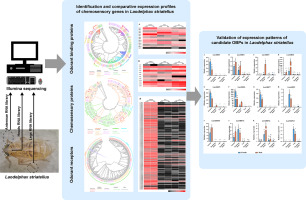当前位置:
X-MOL 学术
›
Comp. Biochem. Physiol. D Genom. Proteom.
›
论文详情
Our official English website, www.x-mol.net, welcomes your
feedback! (Note: you will need to create a separate account there.)
Identification and comparative expression profiles of chemosensory genes in major chemoreception organs of a notorious pests, Laodelphax striatellus.
Comparative Biochemistry and Physiology D: Genomics & Proteomics ( IF 2.2 ) Pub Date : 2019-12-02 , DOI: 10.1016/j.cbd.2019.100646 Yao Li 1 , Jia Hu 2 , Yin Xiang 2 , Yunye Zhang 2 , Danyu Chen 2 , Fang Liu 3
Comparative Biochemistry and Physiology D: Genomics & Proteomics ( IF 2.2 ) Pub Date : 2019-12-02 , DOI: 10.1016/j.cbd.2019.100646 Yao Li 1 , Jia Hu 2 , Yin Xiang 2 , Yunye Zhang 2 , Danyu Chen 2 , Fang Liu 3
Affiliation

|
The small brown planthopper, Laodelphax striatellus (Stål) (SBPH), is a notorious rice pest in East Asia and damages the host by feeding on the phloem and transmitting virus particles. Although SBPH relies on chemosensory perception for seeking the host, courtship, selecting oviposition sites and spreading virus particles, a systematic study of chemosensory genes in SBPH is lacking. In this study, we identified multi-gene chemosensory families from the transcriptome of SBPH olfactory organs and analyzed their expression patterns in male and female tissues. Among the chemosensory genes, 14 odorant-binding proteins (OBPs), 12 chemosensory proteins (CSPs), 7 sensory neuron membrane proteins (SNMPs) and 95 odorant receptors (ORs) were identified and annotated in SBPH olfactory organs. Based on expression profile and phylogenetic analysis, LstrOBP1, 2, 5, 6, 7, 10, LstrSNMP1, and most LstrORs showed an antennae-enriched expression pattern, which suggests an olfactory role for these genes. Relative expression of LstrOBPs was validated by quantitative real-time PCR. Our findings provide the genetic information for disrupting the feeding behavior of SBPH, which is essential for developing eco-friendly pest management technologies.
中文翻译:

在臭名昭著的害虫Laodelphax striatellus的主要化学感受器官中的化学感应基因的鉴定和比较表达谱。
小型褐飞虱,Laodelphax striatellus(Stål)(SBPH)是东亚一个臭名昭著的水稻害虫,它通过吃韧皮部和传播病毒颗粒来破坏寄主。尽管SBPH依靠化学感应知觉来寻找宿主,求爱,选择产卵位点并传播病毒颗粒,但仍缺乏对SBPH中化学感应基因的系统研究。在这项研究中,我们从SBPH嗅觉器官的转录组中鉴定了多基因化学感觉家族,并分析了它们在男性和女性组织中的表达模式。在化学感觉基因中,在SBPH嗅觉器官中鉴定出14种气味结合蛋白(OBP),12种化学感觉蛋白(CSP),7种感觉神经元膜蛋白(SNMPs)和95种气味受体(OR)。根据表达谱和系统发育分析,LstrOBP1,2,5、6、7、10,LstrSNMP1和大多数LstrORs都显示了富含天线的表达模式,这表明这些基因具有嗅觉作用。LstrOBPs的相对表达已通过实时定量PCR验证。我们的发现为破坏SBPH的摄食行为提供了遗传信息,这对于发展生态友好的害虫管理技术至关重要。
更新日期:2019-12-03
中文翻译:

在臭名昭著的害虫Laodelphax striatellus的主要化学感受器官中的化学感应基因的鉴定和比较表达谱。
小型褐飞虱,Laodelphax striatellus(Stål)(SBPH)是东亚一个臭名昭著的水稻害虫,它通过吃韧皮部和传播病毒颗粒来破坏寄主。尽管SBPH依靠化学感应知觉来寻找宿主,求爱,选择产卵位点并传播病毒颗粒,但仍缺乏对SBPH中化学感应基因的系统研究。在这项研究中,我们从SBPH嗅觉器官的转录组中鉴定了多基因化学感觉家族,并分析了它们在男性和女性组织中的表达模式。在化学感觉基因中,在SBPH嗅觉器官中鉴定出14种气味结合蛋白(OBP),12种化学感觉蛋白(CSP),7种感觉神经元膜蛋白(SNMPs)和95种气味受体(OR)。根据表达谱和系统发育分析,LstrOBP1,2,5、6、7、10,LstrSNMP1和大多数LstrORs都显示了富含天线的表达模式,这表明这些基因具有嗅觉作用。LstrOBPs的相对表达已通过实时定量PCR验证。我们的发现为破坏SBPH的摄食行为提供了遗传信息,这对于发展生态友好的害虫管理技术至关重要。











































 京公网安备 11010802027423号
京公网安备 11010802027423号